Gregory Euclide: Observation Infiltration
Gregory Euclide: Observation Infiltration. Minnesota Marine Art Museum
On display through May 24, 2020 is an exhibition of 30 artworks by Gregory Euclide, a mixed-media artist and art teacher living in St. Peter, MN. The exhibition Observation Infiltration showcases his unique style, materials, techniques, and subject matter. His works are a mixture of drawings, paintings, sculptures, and dioramas exploring landscapes, water, and the collision of nature and humankind. He uses a variety of found objects, both natural and synthetic, and traditional art materials to explore our impact on the natural world. Euclide invites us to explore worlds where he blends real and imagined images, objects, and materials to evoke feelings of nostalgia, question the reality of the present moment, and provide a look toward the future.
His imagined landscapes contain elements of urban architecture, woodlands, water, and pastoral rural scenes composed with a variety of found natural materials such as wood, dried plants, leaves, and seeds, as well as man made found materials such as plastic bags, cigarette butts, Styrofoam, fishing line, bubble wrap, and other plastic garbage. He combines these found materials with background imagery made with traditional art mediums such as paint, charcoal, pencil, and Japanese Sumi ink on whiteboard. The interplay between 2D and 3D elements, natural and synthetic materials in complex layers, allows viewers to delve into imagined worlds, and question what is real and what is imagined.
Euclide explains:
“The depiction of land has often been used as a means of celebrating or critiquing culture. The use of pastoral views, banal architecture and everyday trash problematize the traditional definitions of a natural landscape. Through the process of transforming and miniaturizing materials found in the land, objects, in their new context, are no longer discernible as natural or man-made. The juxtaposition of representational modes and materials create a hybrid space where the romanticized and actual intermingle. Contrasts between the flat, painted vistas and artifacts from the land expose the illusion of representation and subsequently confuse the pictorial space, calling into question the authenticity of the objects. The forms fracture the pictorial space, at times, inhabiting the frames, robbing them of their ability to define a single view and inviting a phenomenological exploration by the viewer.”
The inspiration for each artwork begins with a walk in nature in various locations, exploring the natural world, carefully noting details, and collecting found materials.
“I start with the assumption that I am going to be making something about land and my experience with it. I was raised in the rural parts of Wisconsin and much of my free time was spent playing in the tree lines and ravines between farm fields. At the time I just thought of them as forests albeit very thin and long. When I was spending a lot of time in these places I was observing the patterns and intricacies of change. I wasn’t thinking about how the space I was in was only there because it could not be farmed or how in our culture children did not have to work giving them the luxury of playtime. Now, when I take a walk I can’t help to think about those types of things. When I was a child it was an exploration of the physical world that captivated me and now it is a mixture of both the physical and the conceptual.”
Gregory Euclide (American, b. 1974), What I Found at the Falls What Cautions Release on the Land, 2013, mixed media. Media: acrylic paint, dyed hair, euro cast, fern, found foam, paper, photo transfer, pine cone, plastic bag, sedum, sponge, waxed thread, wire, and wood
Referring to What I Found at the Falls What Cautions Release on the Land, pictured here, Euclide states:
“At this time I was working with a lot of different materials - resin, paper, acrylic paint, found foam, wood, artifacts from the land. I wanted to create a scene which contained culturally accepted scenes of beauty, vistas… along with what I witnessed on a daily basis, the general pollution of humans. In this work we see bucolic scenes only to be broken up by cascades of blue resin, plastic trees and found styrofoam.
I have on countless occasions gone for a long walk off the path at a national park or scenic area, thinking as I walk ‘is it possible that I am the only one who has been here?’ - only to look around and find Coke cans, plastic bags or cigarette butts. I noticed that this material was as much a part of the current landscape as pine trees. I wanted to build these beautiful objects that express the current complexities of my experience in the environment.”
Gregory Euclide
Gregory Euclide holds an M.F.A. (Master of Fine Arts) in Studio Art from the Minneapolis College of Art and Design, Minnesota, a B.F.A. (Bachelor of Fine Arts) in Studio Art from the University of Wisconsin-Oshkosh, Wisconsin, and a B.A.E. (Bachelor of Arts in Education) in Secondary Art Education from the University of Wisconsin-Oshkosh, Wisconsin.
His work is also featured on the 2012 Grammy Award winning album covers of the musical group Bon Iver and on the cover of McSweeney’s Quarterly Concern #43. Euclide was awarded three Minnesota State Arts Board Artist Initiative Grants through the National Endowment for the Arts, and a Jerome Foundation Residency through the Blacklock Nature Sanctuary. In addition, he was a recipient of the 2011-12 Jerome Foundation Fellowship for Emerging Artists and the 2015-2016 Mcknight Fellowship for Visual Artists. Euclide received his MFA from the Minneapolis College of Art and Design (MCAD).
The exhibition and artist appearances are made possible by the voters of Minnesota through a grant from the Southeastern Minnesota Arts Council thanks to a legislative appropriation from the arts and cultural heritage fund.
Jon Swanson
Curator of Collections & Exhibitions, Minnesota Marine Art Museum



